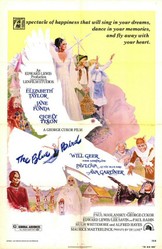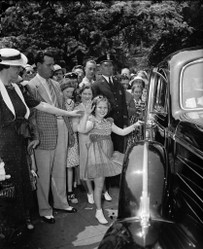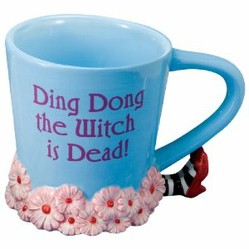I saw "The Blue Bird" as a kid with my little brother when it came out and neither of us was very impressed--we were bored, actually--but the movie stuck with me through the years for some reason. There was something about the melancholy tone and the lilting soundtrack I never forgot.
When I saw the film again on TV some years later I was touched by some of the more tender and thought-provoking episodes. There is a scene where the children are holding what they thought were blue birds but the creatures have passed away in their hands; Elizabeth Taylor as a sort of fairy godmother explains to them that the birds were just fantasies and that all fantasies die eventually. She then sings a very sad song about children growing up and the death of childhood dreams as the two children wander through a field, holding the limp birds in their hands and crying very realistically.
In another scene the children find themselves in a sort of "holding pen" for children about to be born. They encounter a boy and a girl who beg not to be born because they'll be separated. The boy says to the girl that she'll know him if she finds him on earth, "I'll be the saddest man you've ever seen." Mytyl and Tytyl meet their future brother who explains excitedly that their mother doesn't even know she's pregnant yet, but that his time on earth won't last--he'll die after only a few years.
It's hardly the stuff of uplifting childhood film fun, but as an adult viewer I find it takes on a new meaning. I disagree that the music is forgettable; When I heard the songs again as an adult I had remembered every word and note. Also as an adult, some of the long stretches of ballet dancing that I found interminable as a kid now appear to be beautiful to me.
I think the movie IS clunky, poorly constructed and perhaps a bit too bland, lacking in the sort of Disney spark of magic most audiences are used to. I think the best way to approach it, in any country, is as one would approach any film made in ANOTHER country. In the same way that appreciating Japanese Anime requires some sort of understanding of the medium, I don't think you can compare "The Blue Bird" to, say, "The Wizard Of Oz" or anything that Disney has done (outside of, say, "Fantasia," which takes some similar risks, albeit with more successful results).
"The Blue Bird" has been notoriously hard to track down and I think that's a shame (it does pop up on Youtube now and then, of course). I don't think it could ever be popular in the States but I tracked down an English language release a couple years ago and was not surprised to find the film has had a longer shelf life in other parts of the world, and the Soviet crew and performers who worked on the film were quite proud of how it came out.
I think it is far from the worst film ever made as some claim. I think it has some noble aspirations and some good performances, particularly from Elizabeth Taylor who, in some behind the scenes footage on the DVD, seems to be a gentle, nurturing woman having a wonderful time with the kids on the set. I think the soundtrack, some of the visuals and the overall melancholy tone is unique and memorable and I've watched the film several times, without using the cushion of irony.
At the very least, I suppose, the blue birds featured in the film are not CG-animated plush-toy-ready caricatures who think flatulence is funny! Well, until some big Hollywood producers decide to revive the concept some day, and the "Blue Bird" will try to fly again...
















 Tips To Help You Stay On A Fitness Routineon 07/25/2013
Tips To Help You Stay On A Fitness Routineon 07/25/2013
 Tips To Look Out For In A New Relationshipon 07/24/2013
Tips To Look Out For In A New Relationshipon 07/24/2013
 Four Stupid Movieson 07/24/2013
Four Stupid Movieson 07/24/2013
 Five Stupid Songson 07/21/2013
Five Stupid Songson 07/21/2013



Comments
I suppose the story behind it is more intriguing than the film but I'd be curious to know what anyone else thought. Most people I know hate it but a couple of my friends really enjoyed it! Hmm... :)
I must confess I've never seen this film. I'm intrigued and now must add this to my list of must see movies.
I love this sort of geeky film stuff! Yes, I really like Patsy Kensit and think she is under-rated.
Thank you! Yes, neglected to mention the actors who played the kids--Patsy is really good in it! And the role of her brother is played, inexplicably, by the American-accented Todd Lookinland, brother of Mike, who was "Bobby" in "The Brady Bunch," hee hee...
I enjoyed this review - thanks for putting the film up. I notice Patsy Kensit plays the little girl - she's still very well known in the UK. The colour of the film looks nice and rich, saturated.